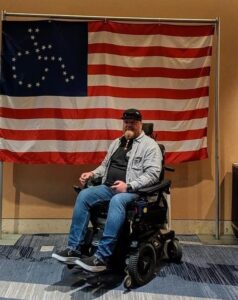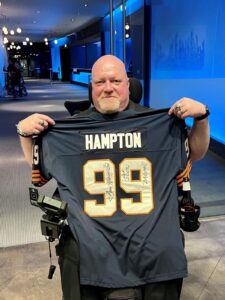
Jim Thew joined the Navy in 1991 and was stationed as an aircraft mechanic at the Naval Air Facility Atsugi in Ayase, Kanagawa, Japan, where he met his wife, Kumiko. In 1999, they moved to Illinois to take care of Jim’s dad. Shortly afterward, Jim started experiencing respiratory issues and decided to seek help.
“I was having severe coughing fits, so I went to a pulmonologist who performed scans on my chest,” says Jim. “What he found was chemical scarring and the lower half of my lungs didn’t seem to be working as efficiently as they should have been. My lung capacity and muscle strength were both low.”
The doctor referred him to a neurologist who also performed multiple tests. Jim also did research on his own. “I remember a lot of veterans getting multiple sclerosis, so having been in the Gulf War, I thought that it might be Gulf War Illness,” he says.
Gulf War Illness is an umbrella term that refers to the unexplained illnesses experienced by veterans of the 1991 Gulf War.
“I also did some genealogy research to see if it was inherited ALS. I went back pretty far and couldn’t find any history of it in my family. I then felt like it had to be linked to my military service. ”After three years, Jim was finally diagnosed with ALS. At the time of his diagnosis, ALS was not yet recognized as a service-related disease for those who had served in the military – only for those who developed the disease while on active duty. Because of this, Jim and Kumiko’s family was unable to get assistance from the government and were struggling financially.

“Before we were able to connect Jim’s ALS to his military service, we had to file for bankruptcy because Jim couldn’t get a job,” says Kumiko. “I worked, but it was only part-time. A lot of veterans with ALS went through this. Many of them used fundraisers to help with medical and other living expenses. We didn’t want to have to do that.” Jim was determined to get ALS recognized as a service-connected disease for those no longer on active duty.
“I decided to come together with five other veterans living with ALS to work on getting ALS recognized for those who served in the Armed Forces. We had someone representing almost every branch including a general in the Air Force.”
In 2008, thanks to their efforts and those of the greater ALS community, ALS was recognized by the Department of Defense as a service-connected illness for those who served.
“Unfortunately, some of our group had passed by then, so they were not able to be there,” says Jim. “But the fact is that we didn’t do this work for ourselves, we did this for each other – for those who went before us and for those who will go after us. We don’t want anyone to have to go through the fight that we had to go through.
“Even after the service-connection to ALS was recognized in the U.S., it still took me three years to obtain VA full benefits. We have gone through some dark and tough times.”
Despite the ups and downs of his ALS journey, Jim is thankful for the people he has met since his diagnosis.
“I’ve met some amazing people, like ALS Support Services Coordinator, Julie Stowell, RN, from the Les Turner ALS Foundation, who immediately helped me when I needed a new respiratory device,” he says. “When I was hospitalized a few years back with H1N1, Drs. Lisa Wolfe and Teepu Siddique of the Lois Insolia ALS Clinic at the Les Turner ALS Center at Northwestern Medicine made sure to check on me. I am also grateful for all the veterans and their families that I have met who are living with ALS.”
Please consider making a donation so that veterans and all those living with ALS like Jim can live comfortably and receive the care and support they need.

